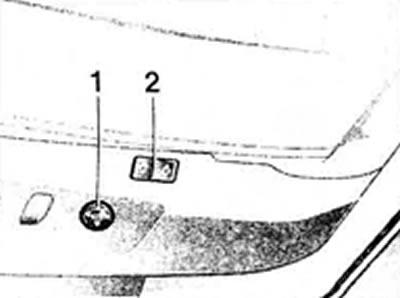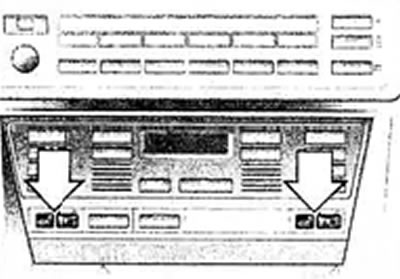The degree of shock absorption from the side of the road has been carefully matched to the characteristics of the running gear. Together with the seat belts, belt tensioners and, of course, the airbags, the stable support structure of the seats ensures the highest level of safety. Thanks to the multilayer structure of the seat filler, the high percentage of natural fibers and the complex internal ventilation system of the seat, a person feels relaxed and does not get tired while driving - and even on long trips. The lumbar and shoulder supports ensure the optimal position of the spine.
Seat adjustment
For your own safety, we ask you to observe the following seat adjustment rules. Do not adjust the driver's seat while driving. If it moves unexpectedly, it could cause you to lose control of your vehicle and lead to an accident. The seat belt should fit as close to the body as possible. Otherwise, in a frontal collision, the lap belt may jump up over the thighs and injure the lower abdomen. In addition, with a loosely fitting belt, its holding effect is realized with a delay.
It is unacceptable that while the car is moving, the back of the front seat deviates far back (this applies primarily to the passenger seat), since in the event of an accident there is a danger "slippage" person under the seat belt, which in this case will not be able to perform its protective function.
The front seats must not be moved back if the vehicle is moving downhill (for example, along the ramp of multi-storey garages or along mountain roads), as the automatic belt height adjustment system may be disengaged.
Seats with manual adjustment

1. Longitudinal adjustment. Pull the handle to move the seat to a comfortable position. After releasing the handle, rock the seat back and forth slightly until it locks securely.
2. Height adjustment. By pulling the handle, adjust the seat height by loading the cushion with its own weight or by standing up from it.

3. Backrest adjustment. By pulling the handle, adjust the inclination of the backrest by leaning back or leaning forward
4. Cushion angle adjustment (for driver's seat only). Pull the handle to move the cushion to the desired position.
To unload the vertebral discs, sit with the maximum shift back, leaning with your entire back on the seat back. The ideal posture is one in which the head is in line with the spine.
To reduce muscle tension on long journeys, you can slightly increase the backrest. At the same time, however, it should be possible to drive the car when the arms lying on the highest point of the steering wheel are slightly bent at the elbows.
Lumbar support
See Signature Comfort Seat description below.
Headrests

The head restraints can be adjusted in height by pulling them out of their sockets or pushing them back.
The inclination of the headrests can be adjusted by turning them around the horizontal axis.
Headrests reduce the traumatic consequences of accidents for the cervical vertebrae.
The center of the head restraints should be approximately at ear level.
Sports type seats

This seat has the additional ability to adjust the knee support.
Pull the handle to position the knee support in a comfortable position for you.
Power seat

1. pillow tilt adjustment
2. longitudinal adjustment of the seat
3. seat height adjustment
4. backrest adjustment
5. Adjusting the height of the headrest The angle of the headrest is adjusted manually.
For your own safety, be sure to follow the adjustment instructions above.
Branded comfort seat

For this seat, lumbar and shoulder support adjustments are additionally provided.
1. Lumbar support
By pressing the switch in front or behind, respectively, the increase or decrease in the convexity of the backrest contour is achieved.
When you press the top or bottom of the switch, the convex area of the circuit moves up or down.
The contour of the back can be modified so that its protruding part fits into the cavity of the lumbar spine, creating support for it.
This provides support for the upper pelvis and spine, contributing to a correct and loose fit.
2. Shoulder support
Pressing the on/off switch changes the angle of the upper backrest.
Thanks to this adjustment, the support of the back is also ensured in the shoulder area. This makes the landing looser and unloads the muscles of the shoulders.
Seat installation will be optimal if the following recommendations are followed.
For driver and front passenger:
1. Pull the top of the back as far back as possible.
2. Adjust the seat for the best fit as described above.
3. Pull the top of the backrest forward to provide comfortable shoulder support. For the front passenger with the backrest tilted back:

1. Pull the upper part of the back to the back.
2. Slightly increase the inclination of the cushion.
3. Slightly increase the inclination of the backrest.
4. Move the upper part of the backrest forward.
When changing the longitudinal position of the seat, make sure that the seat belt, as before, fits snugly against the body, otherwise it will not be able to perform its protective function.
Heated seats

To heat the seat cushion and backrest, you must first turn the ignition key to position 2. Press the button to turn it on and off.
When the seat heating is switched on, the green control lamp mounted in the button lights up.
The intensity of heating is set by a corrugated wheel - regulation takes place in thermostatic mode.
